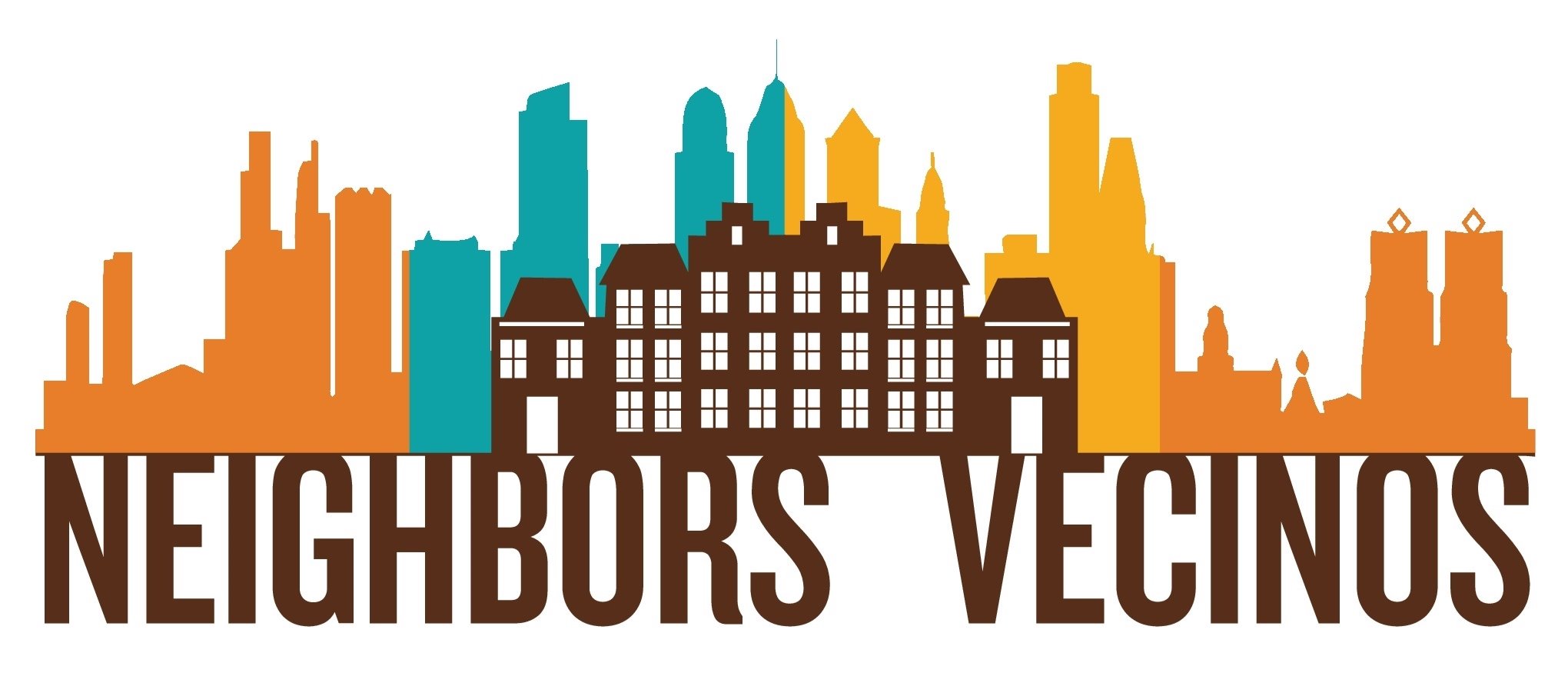Earliest Puerto Rican Settlements in Philadelphia: Southwark, Spring Garden and Northern Liberties
Dr. Victor Vazquez-Hernandez
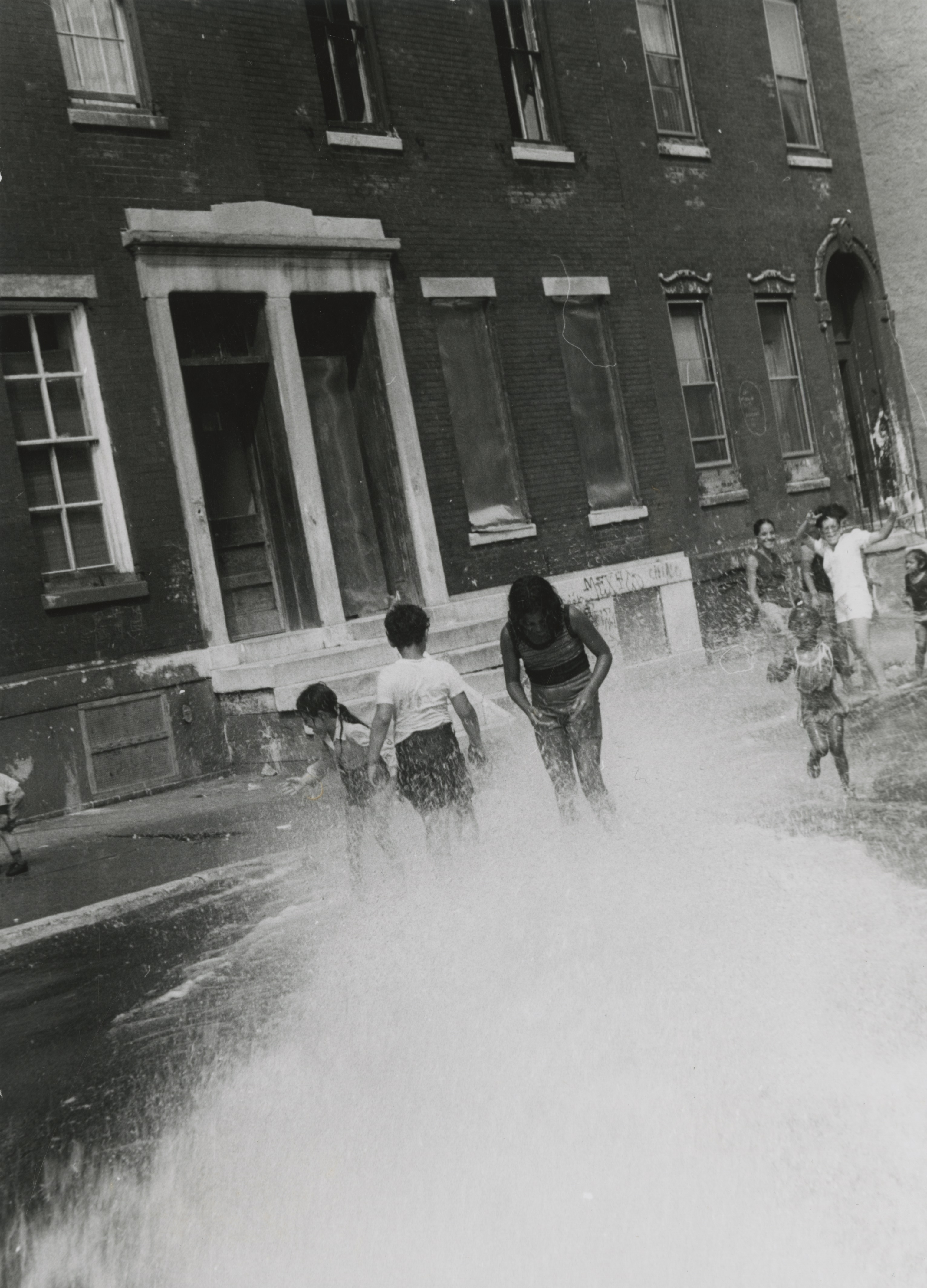 |
|
Neighborhood children run through the fire hydrant's spray Image from Taller Puertorriqueño's archives |
During the first half of the 1900s, Puerto Rican settlement in Philadelphia shifted from widespread dispersal to concentration. Puerto Ricans along with other groups with Hispanic heritage established enclaves within other immigrant settlements in Southwark, Spring Garden and Northern Liberties, and movement between the areas often followed employment opportunities.
The largest concentration of Pan-Hispanics in the interwar period was in an enclave located within the neighborhood of Southwark. This area was bounded by Fifth Street on the west, Locust and Second Street on the east, and Bainbridge Street on the south. The northern section of the enclave, known as Society Hill, had once been the home of old Philadelphian families and upper-class German-Jews, but by World War, these areas had become the home of the working-class. In this period, Puerto Ricans and other Spanish-speakers shared the area with the “new’ immigrants of the time: the Polish and the Italians.
The enclave of Southwark was centered along Head House Market that ran along Second Street between Pine and South Streets. In the early 1920s, the broader boundaries of the concentration of Latinos in Southwark included Pine and Bainbridge Streets on the north and south and the Delaware River and 5th Street on the east and west. Spanish-speaking residents in Philadelphia were scattered, with pockets of them stretching further south, as well as in Kensington and West Philadelphia. The predominant group of Latinos in this area were Spaniards. Cigar manufacturing in the city at the time was concentrated in west Southwark, Northern Liberties, and North Philadelphia; many Puerto Rican cigarmakers in this period resided in the same neighborhoods, close to their businesses. The largest cigar manufacturing company in Philadelphia at the time, the Bayuk Brothers Cigar Company, was located at the southwest corner of Bainbridge and 10th Streets in the heart of Southwark.
By the 1920s there were at least 10 major cigar businesses owned by either Spaniards or Cubans.Several of these shops were situated in or around the Southwark settlements. Jose Alvarez, located at 58 S. 2nd Street; Juan G. Blanco, located at 42 N. 11th Street; Charles Lasa, located at 1343 Arch Street; Ramon Azoque & Co., located at 808 Chestnut Street; and Bienvenido G. Padilla, located at 103N. 5th Street, were some of the popular Southwark cigar stores. Montero Cigars Manufacturing, located at 1610 Susquehanna Avenue; Isidor M. Hernandez, located at 1543 Susquehanna; Caballero, located at 1824 Ridge Avenue where many Hispanic women worked; and Frank Estrada, located 3242 W. Allegheny Avenue, were all found in North Philadelphia.
By 1910, a clear picture of the residential patterns of Puerto Ricans began to emerge. The Spring Garden enclave, though concentrated in certain blocks, was more spread out than the one in Southwark, thereby covering a larger geographic area. The concentration of Spanish-speakers was in the northeast quadrant of the Fifteenth ward. In this area, Puerto Ricans shared the neighborhood with “older” immigrant groups, especially the Irish. The area also had a very large concentration of Polish and Italian immigrants. In this period, Puerto Ricans began to concentrate in an area of Spring Garden bounded by 18th Street on the west, Girard Avenue on the north, Broad Street on the east, and Vine Street on the south. The Latino group in Spring Garden was diverse; besides Puerto Ricans, the enclave also included Spaniards, Cubans, Mexicans, Hondurans, Salvadorans, Chileans and Peruvians. In addition, there were numerous Hispanics that had inter-married with native-born Whites.
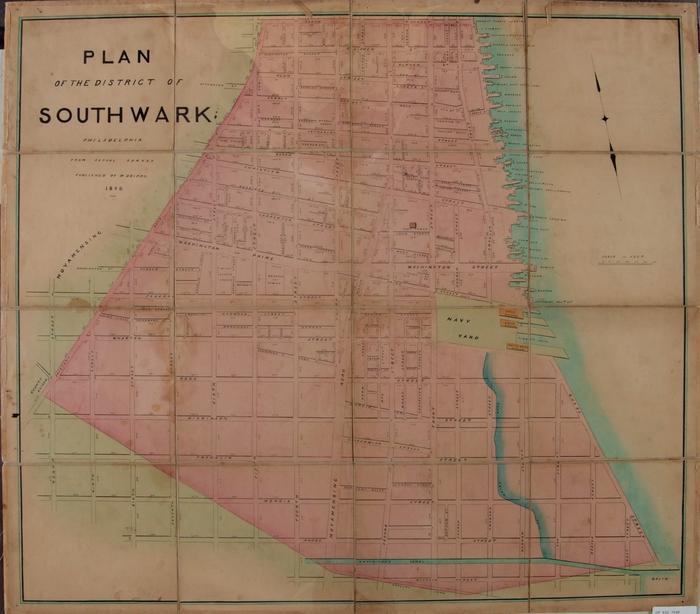 |
|
Map of Southwark Neighborhood Image from the Historical Society of Philadelphia |
By 1920, the Spring Garden enclave reflected the growth of the Spanish-speaking population in the city. Many of the residents had arrived during World War I. The Spring Garden enclave became even more concentrated as many residences were converted into boarding houses. The housing stocks in this neighborhood—especially along Spring Garden, Mount Vernon, Green, and Wallace streets—were three and four stories high and ideal for subdivision. These homes were originally built for wealthy Philadelphian families, who began to leave the neighborhood in the early 1900s for communities developed in the West Philadelphia vicinity. Many of the Puerto Ricans living in these newly divided apartments were machinists and other laborers working nearby at the Baldwin Locomotives Works factory. Given the industrial jobs in the area and the converted boarding houses for both men and women, the population of Spring Garden grew tremendously. For instance, 85% percent of the Spanish-speaking residents in 1920 arrived between 1914 and 1919.
A third concentration of Puerto Ricans during the first half of the twentieth century was located in the Northern Liberties area. Historically, Northern Liberties had existed since the time of the American Revolution. In Northern Liberties, the Pan-Hispanic enclave was divided into two sections, the first being the area south of Spring Garden Street where meatpacking plants were located. This area was commonly referred to as the tenderloin. The second section located north of Spring Garden Street was called Marshall Street. The Hispanic sections of the Tenderloin in Northern Liberties were clearly identified by the 1920s. The largest Spanish-speaking section of this area was bordered by Spring Garden Street and Seventh Street on the east, Vine Street on the south, and 10th Street on the west. The second and smaller section of Latinos lived in the area bordered by Spring Garden Street on the north, 3rd Street on the east, Noble Street on the west, and Orianna Street on the south. This area also included burlesque theaters, cabarets, dance halls, prostitution, and gambling houses.
The Marshall Street portion of this district was the business portion of the neighborhood, with its small shops catering to immigrants and run mostly by Jewish merchants. This area was bordered by Spring Garden Street on the south, Girard Avenue on the north, 10th Street on the west, and Front Street on the east. The market was an important source of both employment and food for the Puerto Rican community in Northern Liberties. In this area, Cubans—especially cigar makers and small shop owners along Marshall Street—were the premier group of the Spanish-speaking community.
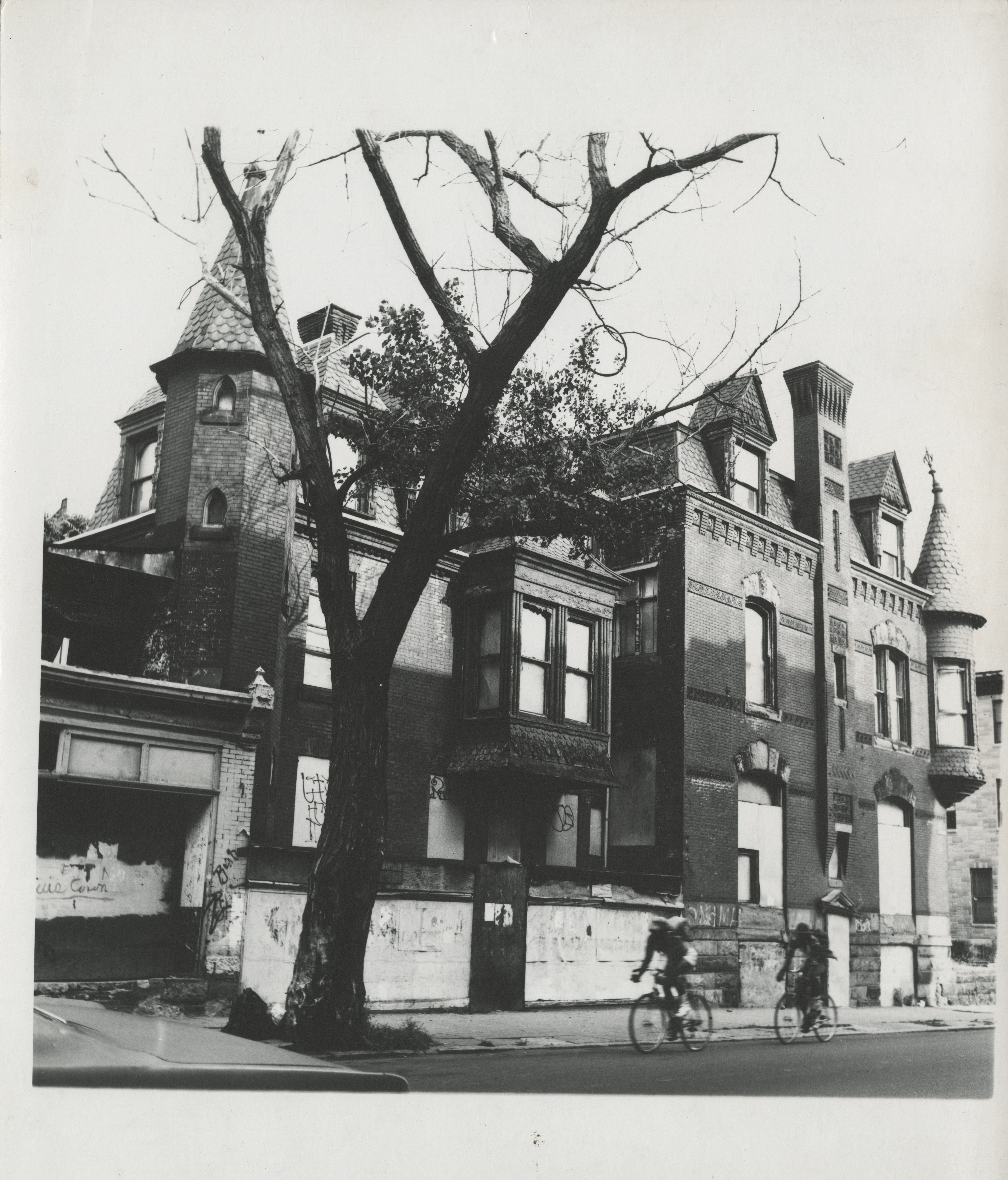 |
|
A West Philadelphia home with boarded windows and graffitied walls Image from Taller Puertorriqueño's archives |
When the Bayuk Brothers Cigar Company moved from their location in Southwark to 9th Street and Columbia Avenue (now Cecil B. Moore) in North Philadelphia, many cigar makers also moved closer to this location, especially to the northernmost sector of Marshall Street. This move contributed to the expansion of the Latino Northern Liberties enclave and created a corridor of housing, business, employment, and shopping opportunities for Puerto Ricans in the neighborhood. This eventually became the southernmost section of the Puerto Rican community that evolved in the post-World War II period.
In the early 1950s, the urban development projects that included the construction of Interstate 95 contributed to people moving out of Southwark. Some Puerto Ricans moved to Northern Liberties and beyond while others moved further south, establishing an enclave in South Philadelphia. Urban development also led to changes in Spring Garden; along with lower rent and increased employment opportunities, the North Philadelphia industrial areas drew more Puerto Ricans to that part of the city.
The three enclave neighborhoods of Southwark, Spring Garden, and Northern Liberties that Puerto Rican residents established during the first half of the 1900s reflected, from a geographical perspective, larger ethnic housing patterns developing in the city. The city already had begun to exhibit segregated residential patterns. Some of these patterns continued unabated into the second half of the twentieth century.
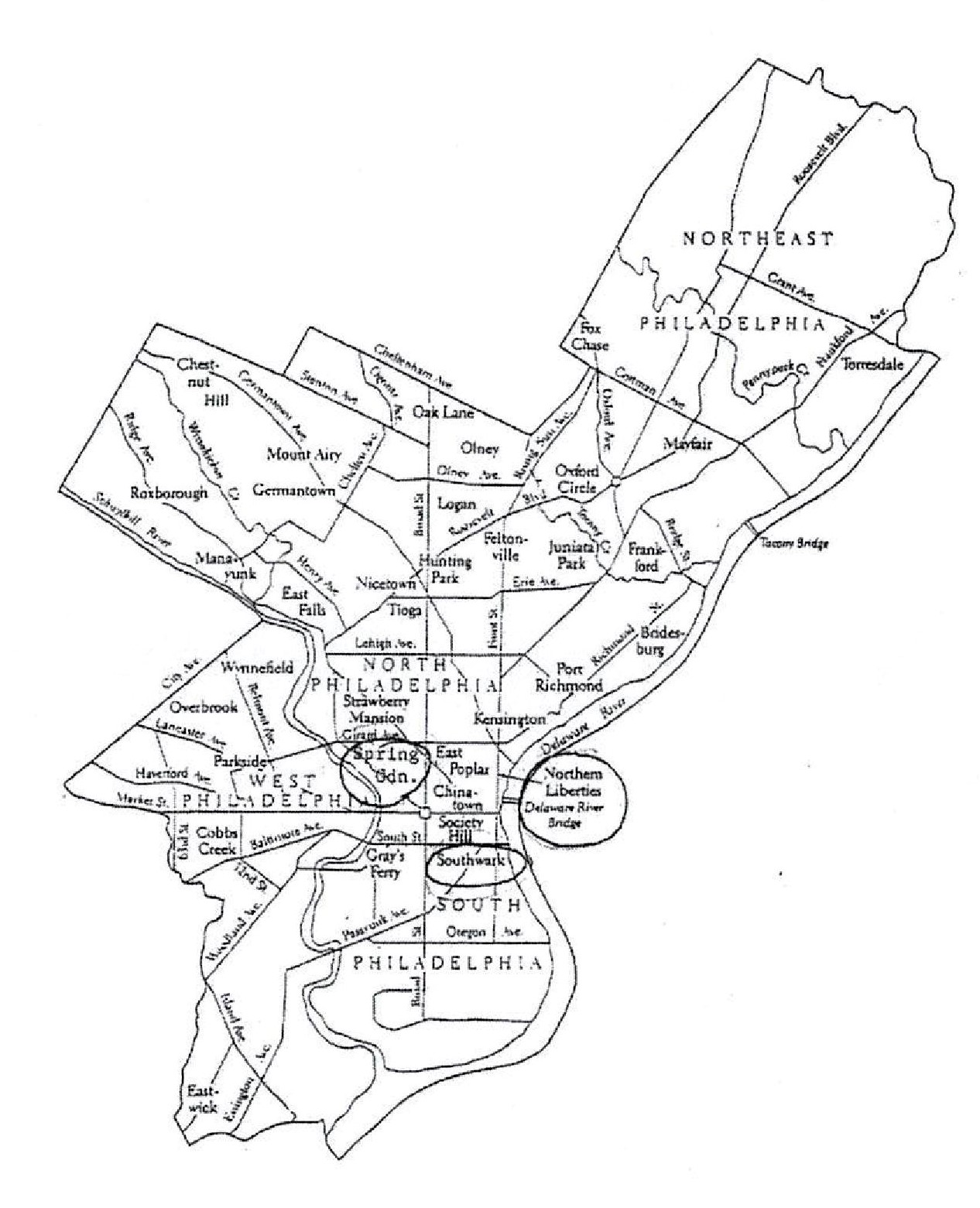 |
|
Circled on this map are the three "barrios" where Puerto Ricans settled: Spring Garden, Northern Liberties, and Southwark. Map provided by author. |
Author Biography
Dr. Victor Vazquez Hernandez is an Associate Professor, Sr., in History at the Miami Dade College-Kendall Campus. Dr. Vazquez has written two books on the Puerto Rican Diaspora in the United States: The Puerto Rican Diaspora: Historical Perspectives (co-edited with Carmen T. Whalen, Temple Press, 2005), and Before the Wave: Puerto Ricans in Philadelphia, 1910-1945 (Center for Puerto Rican Studies, Hunter College, CUNY, 2017). He has also written numerous essays and is currently working on a History of Puerto Ricans in Florida.
See the Spanish version of this page here.
Philly Immigration Stories: Geography
- Read a history of the Italian Market here.
- Greater Northern Liberties: Ukranian Immigration in North Philly
- In Chinatown, the Friendship Arch at the intersection of 10th and Arch Street is the first gate to be built by authentic Chinese artisans in the country and is emblematic of Chinatown’s community.
- The German Catholic community of Greater Northern Liberties established St. Peter the Apostle in 1842.
- The German Society of Pennsylvania (GSP) moved to this site in Greater Northern Liberties in 1888.
- In Greater Northern Liberties, the St. Nicholas Eastern Orthodox Church was chartered in 1918 to serve the overflow of congregants from nearby St. Andrew's Russian Orthodox Cathedral on North 5th Street.
- In Chinatown, the Holy Redeemer Chinese Catholic Church has been so successful that it was deemed “a leading Chinatown institution” by The New York Times.
- In University City, The Association of Islamic Charitable Projects (AICP) is a non-profit association that has stressed moderate Islam since its inception in the 1930s.
- In South Philadelphia, St. Paul's Roman Catholic Church was originally founded in 1843 to meet the spiritual needs of the growing Irish Catholic community. But since the turn of the century, St. Paul's has served an increasingly Italian American congregation.
- In Southwark, the Neziner Building , which dates back to 1811, has been used and reused by Baptist, Catholic and Jewish immigrant groups successively over the course of 170 years.
- In Southwark, The Octavia Hill Association was formed in 1898 to improve the condition of working-class housing, providing safe housing for the growing poor black and immigrant populations (primarily Jewish, Polish, and Italian).
- In Washington Square, the St. George Greek Orthodox Church has been home to more than one congregation in its almost 200 year history.
- In South Philadelphia, Maria Innocenza's boarding house was located at 505 Catharine Street.
- In South Philadelphia, the Kesher Israel Synagogue was purchased by a Jewish congregation in 1889, and it has remained a synagogue ever since.
Puerto Rican Geography in Philly
- This video, titled Dutchirican: A Latin@ History of Central PA, is a recording of a panel discussion that took place at HSP in May 2017. Presented by John Hinshaw and Dr. Ivette Guzman-Zavala, the panel focuses around the fact that, from the 1960s to the present, two-thirds of Pennsylvania’s population growth has been the result of Puerto Ricans, Dominicans, Mexicans, and others moving to the Commonwealth.
- PhilaPlace: North Mascher St.
Related Timeline Events
- Early 1900s: Puerto Ricans Begin Settling in Southwark
- 1912: La Milagrosa Church Moves to Spring Garden St.
- 1954: Casa del Carmen is Established
- 1970: 25% North Philly is Latino
- 1975: White Neighbors Firebomb Santiago Family Home in Kensington
- 1990: Puerto Ricans 76% Latino Population in Philly
- 2000:Philly has 3rd largest Puerto Rico population
- 2006:More Puerto Ricans in U.S. Mainland than Puerto Rico
- 2017:2,000 Puerto Ricans Move to PA After Hurricane Maria
Oral History Connections
Head over to the Oral Histories page to listen to the tapes referenced below.
Tape 1951-A: Where did your parents live when they came to the U.S.? "...at 13th and Girard Ave. North Philadelphia." Where do you live now? What was the reason for your moving into your present home? "2nd. Street...Better housing and conditions were better. We used to live in an apartment. My father bought the house and the neighborhood was quieter."
"I went to get an apartment in an all Italian neighborhood and the woman was very cold because I am Puerto Rican."
Tape 1956-A: Where do you live today? What would you say is the racial make-up of your neighborhood? "North Lawrence Street...The majority is Puerto Ricans."
Why do you like this neighborhood? "I'm surrounded by my people. Puerto Ricans. I don't know if that sounds prejudiced but it's just something that I feel."
Tape 1994-A: What type of neighborhood do you live in? "It is predominantly Puerto Rican. It used to be, when we first came, was white people here. They moved out and Puerto Ricans moved in, a few, two or three white families are still on the block. After the Puerto Ricans came, four or five black families moved in, so it is mixed, but mostly Puerto Ricans."
Tape 2007-A: What racial mix was it that lived in the neighborhoods that you lived in in New York? "There were so many, but I don’t remember that there were many whites. They were primarily Puerto Ricans. There were times we lived in neighborhoods that were all Black. Sometimes we lived with all Puerto Ricans and sometimes we lived in mixed areas."
Further Resources
Aponte, Edwin D., David Bartelt, John C. Raines, and Luis A. Cortes. The Work of Latino Ministry: Hispanic Protestants in Philadelphia. Philadelphia: Pew Charitable Trusts, 1994.
Arnau, Ariel. "The Evolution of Leadership in Philadelphia." Pennsylvania Magazine of History and Biography. Vol. 136, No. 1 (January 2012).
Erickson, Eugene P., et al. The State of Puerto Rican Philadelphia. Philadelphia: Institute for Public Policy, Temple University Press, 1985.
Goode, Judith B. and Jo Anne Schneider. Reshaping Ethnic and Racial Relations in Philadelphia. Philadelphia: Temple University Press, 1994.
Gonzalez, Juan D. "The Turbulent Progress of Puerto Ricans in Philadelphia." CENTRO: Journal of the Center for Puerto Rican Studies. Vol. 2, No. 2: 34-41.
Koss, Joan D. Puerto Rican Philadelphia: Migration, and Accommodation. Doctoral Dissertation: University of Pennsylvania, 1965.
Vazquez-Hernandez, Victor. Before the Wave: Puerto Ricans in Philadelphia, 1910-1945. Centro Press: Center for Puerto Rican Studies, 2017.
Vazquez-Hernandez, Victor. "Development of Pan-Latino Philadelphia,1892-1945." Pennsylvania Magazine of History and Biography. Vol. 128 No. 4 (October 2004): 12-15.
Vazquez-Hernandez, Victor. "Tobacco, Trains and Textiles: Philadelphia's Early Spanish-speaking Enclaves, 1920-1936." Legacies Magazine. Historical Society of Pennsylvania, (November 2003): 367-84.
Whalen, Carmen T. and Victor Vazquez-Hernandez. eds. The Puerto Rican Diaspora: Historical Perspectives. Philadelphia: Temple University Press, 2005.
Whalen,Carmen T. From Puerto Rico to Philadelphia: Puerto Rican Workers and Postwar Economies. Philadelphia: Temple University Press, 2001.
Whalen, Carmen T. El Viaje: Puerto Ricans of Philadelphia. Charleston: South Carolina, Arcadia Press, 2006.
Whalen, Carmen T. "Displaced Labor Migrants or the Underclass: African American and Puerto Ricans in Philadelphia"s Economy." In The Collaborative City: Opportunities and Challenges for Blacks and Latinos in US Cities. John Betancur and Douglas C. Gills, 115-36. New York: Garland Publishers, 2000.
Whalen, Carmen T. "Bridging Homeland Politics and Barrio Politics: The Young Lords in Philadelphia." In The Puerto Rican Movement. Eds. Andres Torres and Jose E. Velazquez, 107-23. Philadelphia: Temple University Press, 1998.
